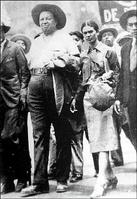Michael Robinson, Gleaner Writer
Frida Kahlo typing a letter against the destruction of the Rockerfeller Center mural.
TWO OF Mexico's greatest cultural icons, Frida Kahlo and Diego Rivera, are the focus of 'Complicities', a photo exhibit opened Thursday at Bolivar Gallery. Mounted under the auspices of the Mexican Embassy, the collection of black and whites is a 35-piece journey through the intertwined lives of these famous painters. But instead of concentrating on the art of Kahlo, the world-renowned surrealist, and Rivera, already an established muralist by the time the two met, the show takes a socio-political perspective to their lives.
In 1910, Rivera launched his painting career with a solo exhibition, a scant two months before the start of the Mexican Revolution. Kahlo, who was three years old at the time, later claimed to have been born that year, signifying her identification with the struggle which was to play an important role in the lives and careers of both artists. Their 'complicities' had begun. The exhibit goes on to traverse some 25 years of their lives, viewed in tandem with the story of their beloved country.
growing pains in mexico
The early 20th century saw Mexico going through some signi-ficant growing pains with a succession of leadership changes and armed civil conflict lasting over a decade. Both artists were staunch nationalists with strong political views and their shared passions inspired them to join the communist party. There are images of Rivera marching through Mexico's streets with fellow party supporters. One powerful image shows Rivera and Kahlo in the midst of a protest, fists held high.
Another image shows Rivera in discussion with Russian revolutionary Leon Trotsky, who was in exile from his home country. Rivera was the chief organiser of Trotsky's arrival in Mexico and had asked Kahlo to host the Russian. Trotsky, one of history's most influential political minds, and Frida, who was separated from her husband at the time, had an affaire. Trotsky was to be assassinated in 1940 and Rivera implicated when it was discovered that the killer had used one of the muralist's cars in the crime. During this trying period, Rivera and Kahlo grew close once again.
One picture shows Kahlo typing a letter for Rivera, protesting the destruction of his 'Man At The Crossroads' mural in New York's Rockefeller Center. The building's managers were at odds with Rivera for his portrayal of Vladimir Lenin

Rivera and Kahlo in a 1st of May march (Mexico City, 1929).
Pin the piece, which depicted workers facing a symbolic nexus of industry, science, socialism and capitalism. Diego was paid in full and the piece was ordered demolished.
The exhibit is an offshoot of Mexico's centenary celebrations of Frida Kahlo's life last year. The centennial featured, among other things, an exhibition at the Palacio de Bellas Artes (Palace of Fine Arts) of over 300 pieces of Frida's work, as well as some of her drawings and writings. Murals by Rivera from the museum's permanent collection were also included in the show, as the centennial coincided with the 50th anniversary of his passing.
compelling look
Bolivar Gallery gives us a compelling look at the work of two artists whose lives and work were about more than art. In a time of upheaval and social flux, the pair stood out as cultural beacons. Frida is particularly exemplary as her prolific output came against the backdrop of a life wrought with unimaginable physical and emotional challenges. Over time, her story and her work have transcended her identity as a Mexican and have touched the lives, hearts and minds of millions.
'Complicities' reminds us that artists have a social responsibility and art needs to stand for something.

